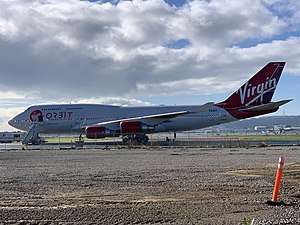Cosmic Girl (aircraft)
Cosmic Girl is a Boeing 747-400 aircraft. A former passenger airliner operated by Virgin Atlantic, it was purchased by Virgin Galactic in 2015 to be used as the first stage launch platform (or mothership) for the air launch stage of the smallsat orbital launch vehicle, the LauncherOne. In 2017, the aircraft was transferred to the orbital launch subsidiary, Virgin Orbit, and its livery updated to Virgin Orbit livery. It attempted its first launch on 25 May 2020.
| Cosmic Girl | |
|---|---|
 | |
| Virgin Orbit 747 Cosmic Girl at Long Beach Airport | |
| Type | Boeing 747-41R 44/32/310 [1][2][3] |
| Manufacturer | Boeing |
| Construction number | 32745[2][3] |
| Manufactured | 2001 [1] |
| Registration | |
| First flight | 25 May 2020 [6] |
| Owners and operators |
|
| In service | |
| Status | Airworthy, in service as a launch platform for LauncherOne launch vehicles. |
| Aircraft carried | LauncherOne orbital rocket |
Airliner
Cosmic Girl was assembled in 2001 at the Boeing Everett Factory.[2] It was configured as a 44/32/310 B747-41R,[1] c/n. 32745.[2] The aircraft's first flight was on 29 September 2001,[2] and it was delivered to Virgin Atlantic on 31 October 2001,[4] where it was registered as G-VWOW.[1]
On 3 November 2005, the aircraft was landing at Runway 27R at Heathrow Airport when a crosswind caused it to roll to the left, and the left-most (No. 1) engine struck the ground.[8]
Cosmic Girl is currently based at the Long Beach Airport.[9]
Launch platform
The jetliner was in-service with the airline until October 2015. The airliner, previously leased by Virgin Atlantic, was purchased outright by Virgin Group for Virgin Galactic, and registered as N744VG, in November 2015.[4][7] A 747 was selected due to its carrying capacity. The acquisition of the 747 allowed the use of separate carrying aircraft for SpaceShipTwo and LauncherOne.[10] With the spinoff of Virgin Orbit in 2017, Cosmic Girl was also transferred.[5]
.jpg)
The air launch to orbit LauncherOne rocket was originally envisioned to operate from the smaller airplane WhiteKnightTwo (WK2) launch platform, used for the suborbital Tier 1b system of WK2 and SpaceShipTwo (SS2). However, as the size of LauncherOne expanded to better encompass the marketplace and acquire marketshare of small launches, the rocket outgrew WK2, leading to the evaluation of bigger launch aircraft, and the acquisition of Cosmic Girl for LauncherOne operations.[4][7] The use of a larger airplane allows doubling of LauncherOne payload capacity to 200 kilograms (440 lb), though with the selection of a 747, ultimately, 400 kilograms (880 lb) may be supported.[11] 747s have previously been used to air launch other craft, including the Space Shuttle Enterprise.[12] The use of Cosmic Girl marks the first use of a 747 as a space launch platform.[13]
The LauncherOne attachment pylon is situated on the left wing, where on a normal 747, the fifth engine attachment point is located for ferrying engines. This point is located between the fuselage and the left inboard engine.[7] LauncherOne would be dropped from Cosmic Girl at a height of 35,000 feet (11,000 m).[14] The maximum payload limit for LauncherOne operations on Cosmic Girl is 400 kilograms (880 lb).[15]
Making its first flight, on 25 May 2020, a privately-funded air-launched rocket, LauncherOne, developed and built by Virgin Orbit failed to reach space after release from his Boeing 747-400, named "Cosmic Girl", over the Pacific Ocean.[16]
See also
| Wikimedia Commons has media related to G-VWOW (aircraft). |
- Stargazer N140SC; the Orbital L1011 mothership for Pegasus rockets
- Balls 8 52-008; the NASA NB-52B mothership for X-15 rocket planes, lifting bodies, and Pegasus rockets
- WhiteKnightOne N318SL; the Mojave Aerospace Ventures mothership for the SpaceShipOne rocketplane
- Shuttle Carrier Aircraft; the NASA B747 mothership that was used to air launch Enterprise
References
- "The Virgin Atlantic fleet of aircraft" (PDF). Virgin Atlantic. Retrieved 23 September 2016.
- "N744VG Virgin Galactic Boeing 747-41R – cn 32745 / 1287". PlaneSpotters.net. Retrieved 23 September 2016.
- "Boeing 747 – MSN 32745 – G-VWOW". AirFleets.net. Retrieved 23 September 2016.
- Chris Gebhardt and Nate Moeller (4 December 2015). "Virgin Galactic unveils Cosmic Girl, dedicated LauncherOne aircraft". NASAspaceflight.com.
- "Ex-Virgin Atlantic G-VWOW is now with Virgin Orbit as N744VG "Cosmic Girl"". World Airline News. 10 October 2017.
- https://spaceflightnow.com/launch-schedule/ - 25 May 2020
- Jeff Foust (4 December 2015). "Virgin Galactic Acquires Boeing 747 for LauncherOne Missions". SpaceNews.
- "Boeing 747-41R, G-VWOW, 3 November 2005". Air Accidents Investigation Branch report. UK Government. Retrieved 23 September 2016.
- "Virgin Orbit's Cosmic Girl Lands in Long Beach". Virgin Orbit. 2017-08-01. Retrieved 2019-02-11.
- Virgin Galactic (7 December 2015). "Virgin Galactic - An Introduction to LauncherOne's Carrier Aircraft Cosmic Girl".
- Andrew Trotman (4 December 2015). "Richard Branson to launch rockets into space using Boeing 747". The Telegraph (London).
- Brian Mastroianni (4 December 2015). "Virgin Galactic plans to launch satellites from jumbo jet". CBS News.
- Virgin Galactic (4 December 2015). "Welcoming Cosmic Girl - Highlights".
- Christian Davenport (3 December 2015). "Richard Branson unveils his rocket's new "mothership", a 747 he calls "Cosmic Girl"". Washington Post.
- Matt Payton (4 December 2015). "Virgin to adapt a Boeing 747 into a flying launchpad for their Galactic spaceship". Metro.co.uk.
- https://spaceflightnow.com/2020/05/25/virgin-orbits-air-launched-rocket-fails-on-first-test-flight/ - 25 May 2020